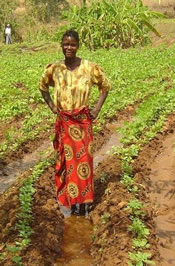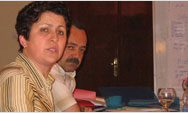 |
Food Security
“To the people of poor nations, we pledge to work alongside you to make your farms flourish and let clean waters flow; to nourish starved bodies and feed hungry minds.”
President Obama Inaugural Speech |
Prompted by rising food prices in 2008, riots and demonstrations erupted in over 40 countries around the world. Unable to afford adequate food, many of the poor in these countries and others are at higher risk for malnutrition, which can have devastating and long-lasting impacts on those suffering now and future generations. Food security is a foundation for building social and economic development. It means that all people in a society have access, at all times, to enough food for an active and healthy life. It depends on agriculture to provide sustenance, incomes and livelihoods for the world’s rural poor – 2.1 billion living on less than $2 per day.
The food supply is increasingly global; recent high food prices hit American families too. Ensuring safe and affordable food at home and abroad requires addressing global agricultural challenges: declining growth in crop productivity while demand rises, emerging diseases and pests that threaten crop and livestock production, declining availability of water, and increasing climatic variability due to climate change.
USAID promotes food security by stimulating rural economies through broad-based agricultural growth, which increases incomes along with food production, reduces poverty, and brings down food prices in local markets for the urban poor.
USAID’s approach

|
| Emily Baziwell, a farmer in Malawi amid her maize, tomato, and bean crops, helped familiarize her village to irrigation, a method that has since successfully spread to other farms.
|
Improving food security is both a humanitarian and development priority. A successful attack on extreme poverty and chronic hunger requires assistance to increase availability, access to, and utilization of food. Economic growth through agriculture is a central and proven tool for many developing countries.
To achieve global food security USAID works with developing countries, civil society, the private sector, and other development organizations to:
- Save lives and halt the slide into hunger and absolute poverty by providing emergency assistance, such as food aid, which protects limited resources of the poor from further erosion and provides a foundation for longer term investments in agricultural productivity and social protection
- Create dynamic rural economies by modernizing the agriculture of small-scale producers - throughout history, including in the U.S., agriculture has driven economic growth, increasing incomes of farm families, much of the poor in developing countries, and creating off-farm employment for the landless rural poor
- Support research and development of improved technologies and sustainable production practices, including biotechnology; expand access to quality seeds and fertilizers, agricultural services, and financing; strengthen farmer organizations and cooperatives as well as agribusiness and value chain development; link small producers to markets; and promote regional trade and market-based policies
- Make rural growth work for the poorest - the extreme poor in rural areas are often landless or face other constraints that prevent them from being commercially viable agricultural producers. Enabling them to take advantage of economic opportunities requires targeted social and economic assistance — “productive safety nets” — ranging from vocational and skills training, to public works, to income generation and programs that provide temporary financial and food assistance
- Improve nutrition security as integral to both humanitarian and agricultural development through approaches such as linking community-based agriculture, health and nutrition programs; diversifying food production with, for instance, home and school gardens; and breeding staple food crops for enhanced nutritional quality.
USAID’s response to the Food Crisis
While food prices have declined from the crisis levels of early 2008, prices continue to be significantly higher in many developing countries. This food crisis and the growing implications of the financial crisis have added to the ranks of nearly a billion people living with chronic poverty and hunger.
The U.S. continues to be the world’s largest food aid donor providing, on average, over half of annual international food aid. In response to the food crisis, the U.S. Government committed over $5.5 billion for fiscal years 2008 and 2009 to fight world hunger. $4.75 billion of these funds were programmed by USAID, to:
Provide immediate and expanded humanitarian response
In FY 2008, USAID provided $2.06 billion in emergency food assistance to 26 countries (Djibouti, Ethiopia, Kenya, Somalia, Sudan, Tanzania, Burundi, Central African Republic, D.R. Congo, Rwanda, Zimbabwe, Zambia, Uganda, Cameroon, Chad, Liberia, Afghanistan, Bangladesh, Burma, Nepal, Sri Lanka, Algeria, Syria, Yemen, Colombia, Ecuador), $129 million of which was designated for buying food locally in Somalia, Ethiopia, Nepal and Tajikistan, for emergency distribution, thus cutting shipping costs and stimulating local production.
Investing in staple food production for vulnerable states
USAID is investing $130 million in FY 2009 for the production and trade of staple foods such as corn, wheat, cassava, sorghum and millet, initially focusing on five West African countries with the greatest need: Ghana, Liberia, Mali, Nigeria and Senegal.
Supporting trade liberalization to reduce price volatility
USAID is working with host countries to reduce barriers to staple food trade and trade-distorting subsidies, help increase market access for agricultural products, and encourage open markets.
Increase availability and use of advanced agricultural technologies
USAID provided $20 million in FY 2008 Famine Funds to the Consultative Group on International Agricultural Research (CGIAR) to disseminate “on the shelf” food staple technologies in sub-Saharan Africa and South Asia.
“The President and I intend to focus new attention on food security so that developing nations can invest in food production, affordability, accessibility, education and technology.”
Secretary of State Hillary Rodham Clinton, remarks to participants at High Level Meeting in Madrid Spain on Food Security for All |
Additional Resources
The IFPRI Food Prices Website contains the latest research from IFPRI on food prices as well as links to news articles and a blog on world hunger.
The Secretary-General's High-Level Task Force on the Global Food Security Crisis Website describes the UN’s approach to the crisis.
The World Bank’s Food Crisis Home Page provides World Bank research, links, and donor news.
IMF’s Indices of Primary Commodity Prices, provide information on primary commodity prices from 1998 to 2008.
Back to Top ^ |




